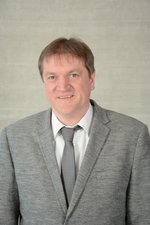The first on-site meeting of the European joint meeting of the DigiTwins4PEDs research project took place at the Stuttgart University of Applied Sciences (HFT Stuttgart). Project milestones, deliverables and strategies for Positive Energy Districts (PEDs) were discussed from 19 to 21 February, paving the way for further progress.
The aim of the project is to drive the urban energy transformation towards PEDs (Positive Energy Districts) together with citizens. The case area is the Nordbahnhof district in Stuttgart, which is facing infrastructural and social challenges due to Stuttgart 21 and the new construction project in the neighbouring Rosenstein district.
Project members from Poland, Austria, the Netherlands and Germany
Participants from Poland, Austria, the Netherlands and Germany were warmly welcomed by Prof Dr Volker Coors and Rushikesh Padsala from the Stuttgart University of Applied Sciences (HFT Stuttgart). The project aims to meet challenges through innovative research methods and participatory processes involving stakeholders and citizens. Despite the availability of urban energy simulation tools, implementation at the local level remains a major challenge. Citizens will be involved in living labs and case studies. Through co-creation and co-learning, the transformation of the district's energy sector will be driven forward together. The project will develop tools and methods for Urban Digital Twins (UDT) to enable citizens to actively participate in the energy transition and make informed decisions.
Data management, research and citizen participation
Dr Ernst Gebetsroither-Geringer and Jan Peters-Anders from the Austrian Institute of Technology (AIT) led the discussion on the Data Management Plan (DMP) and emphasised its importance for the research data management of the project. Dr Barbara Smetschka from the University of Natural Resources and Applied Life Sciences, Vienna (BOKU) presented strategies for stakeholder mapping and analysis for co-designing PEDs with citizen participation. In addition, Stanisław Biernat from InfoSolutions, Poland and Dr Paweł Bogusławski from the University of Environmental and Life Sciences Wrocław (UPWr, Poland) presented the development of the project website, the 3D city model of Wrocław and the project's digital twin platform. This was followed by a lively discussion on the technical development of the energy simulation data model and its integration into the urban digital platform, led by Dr Giorgio Agugiaro from TU Delft.
Excursion to the new Neckarpark
On the excursion day of the new Neckarpark Stuttgart, led by Loannis Papandreou from the City of Stuttgart (STG), the participants learned about the energy-efficient structures. On the 22-hectare site of the former Bad Cannstatt goods station, some 450 apartments, hotels and various service-oriented and commercial facilities are planned with a sustainable energy supply: Heating and cooling will be generated from wastewater, with the energy being used by a low-temperature district heating network using heat exchangers and cascade heat pumps.
The group then visited the public exhibition of the new Rosenstein district to the north of Stuttgart's main station, in the immediate vicinity of the Nordbahnhof district. This is being redeveloped as part of the Stuttgart 21 construction project. The Rosenstein Quarter is currently the largest planned construction project in Stuttgart, with more than 5,000 apartments planned. The DigiTwins4PEDs project addresses two key questions:
1. How the existing Nordbahnhofviertel and the new areas of the Rosensteinviertel can be developed together for the future and provide a sustainable livelihood for all current and future residents?
2. How the Nordbahnhofviertel can be connected to the Rosensteinviertel in terms of energy.
Working with citizens in the Nordbahnhof neighbourhood
Amando Reber from HFT Stuttgart led the discussion on "Co-creative collaboration with citizens in living labs". Reber presented his initial ideas for setting up a living lab in the Nordbahnhof district to interact with citizens. The Urban Digital Twin (UDT) platform will be used in later phases of the project. This is a computerised network of a city's data that can be used as a planning and decision-making tool for urban planning and to simulate energy transition scenarios. The platform will be used to develop energy flexibility strategies together with citizens as part of the Living Lab. Amando Reber and Rushikesh Padsala then presented the social impact and exploitation plans. Other HFT Stuttgart participants in the project are Prof. Dr Christina Simon-Philipp, Professor of Urban Planning and Urban Development at Stuttgart University of Applied Sciences (HFT) and Head of the Centre for Sustainable Urban Development, Professor Dr Bastian Schröter (Sustainable Energy Technology), Max Haag (Managing Director of the Centre of Sustainable Energy Technology) and Marine Paichard (national and international Research Management).
At the end of the three-day meeting, the participants focussed on technological development and stakeholder involvement in the DigiTwins4PEDs project in sub-group meetings. The next steps in the further development of technical energy simulation and visualisation tools for the project were planned in order to join forces for the successful integration of Urban Digital Twins in the co-creation process. Dr Giorgio Agugiaro (Delft University of Technology) moderated the discussion on the further development of the energy simulation data model and its integration with the urban digital platform.
A second project meeting was planned for September 2024 in Vienna to further advance the energy transformation towards positive energy districts.
![[Image: HFT Stuttgart]](/fileadmin/Dateien/Forschung/_processed_/3/9/csm_20240312_Foto_DigiTwins4PEDS_Mitglieder_Foschungsverbund_Exkursion_4fc94ec517.jpg)
![[Image: DigiTwins4PEDs]](/fileadmin/Dateien/Forschung/_processed_/a/5/csm_20240312_DigiTwin4Peds_Partner_Logos.pptx_5766973e9d.png)
